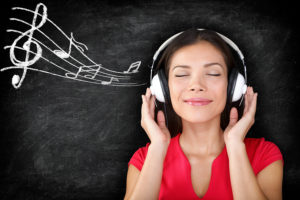 Music has a central role in human society because it so strongly evokes feelings and affects social activities and interactions. The study of music’s influence has greatly increased knowledge of emotion in the brain. Studies show that technology has advanced music and recent studies show dramatic effects on all the brain regions that are related to emotion—amygdala, hypothalamus, hippocampus, nucleus accumbens and critical regions of the cortex including insula, cingulate and orbitofrontal. It shows that music stimulates emotions through specific brain circuits.
Music has a central role in human society because it so strongly evokes feelings and affects social activities and interactions. The study of music’s influence has greatly increased knowledge of emotion in the brain. Studies show that technology has advanced music and recent studies show dramatic effects on all the brain regions that are related to emotion—amygdala, hypothalamus, hippocampus, nucleus accumbens and critical regions of the cortex including insula, cingulate and orbitofrontal. It shows that music stimulates emotions through specific brain circuits.
Previous posts have described the unique effects of music on the neuroplasticity for learning, the development and evolution of language, improvisation, emotions and spirituality. This post will update the specific emotional brain circuits stimulated by music that affect socialization.
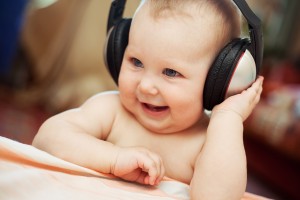 Even very young babies show emotional responses to music. At five months, babies enjoy moving in time to music. In adults, perhaps the most important use of music is in evoking, experiencing and regulating emotions related to social interaction. This includes the use of music in child parent bonding, meetings, performances, religious services and spiritual practices.
Even very young babies show emotional responses to music. At five months, babies enjoy moving in time to music. In adults, perhaps the most important use of music is in evoking, experiencing and regulating emotions related to social interaction. This includes the use of music in child parent bonding, meetings, performances, religious services and spiritual practices.
Music can alter subjective feelings; physiological states through autonomic nervous and endocrine systems; body motor responses such as smiling and tapping; and whole body movement of dancing, clapping and playing of musical instruments.
 Current conclusions are that limbic brain regions such as the amygdala are a major part of the emotional stimulus from music. Also, the reward network that includes the dopamine mesolimbic centers in the nucleus accumbens are critical for the pleasure derived from some music. These centers are essential in all other pleasurable events, including the distorted pleasures of addictions. The hippocampus, which is a critical part of memory and learning in the brain, is a major part of musical effects on social engagement and attachment. This hippocampal effect is more than the influence of memories on emotional states and is described below.
Current conclusions are that limbic brain regions such as the amygdala are a major part of the emotional stimulus from music. Also, the reward network that includes the dopamine mesolimbic centers in the nucleus accumbens are critical for the pleasure derived from some music. These centers are essential in all other pleasurable events, including the distorted pleasures of addictions. The hippocampus, which is a critical part of memory and learning in the brain, is a major part of musical effects on social engagement and attachment. This hippocampal effect is more than the influence of memories on emotional states and is described below.
Unconscious Brain Systems Stimulating “Moving to the Beat”
The unconscious brain circuits for sound appear to be very old in evolution.
 The system for hearing sounds evolved from the vestibular brain network that responds to balance in space. The vestibular system still responds in some ways to sound as well as balance. Two vestibular structures, the saccule and the utricle, respond to vibrations from sounds.
The system for hearing sounds evolved from the vestibular brain network that responds to balance in space. The vestibular system still responds in some ways to sound as well as balance. Two vestibular structures, the saccule and the utricle, respond to vibrations from sounds.
The vestibular system has a strong influence on the effect of loud sounds, especially very low sounds and those that occur suddenly. The vestibular brain nuclei, as well as the auditory cochlear nuclei, are connected to the brain region that activates awakeness, the reticular system. It also mingles with fibers of the autonomic system and the system that innervates the major organs. This can be experienced by lack of balance causing GI symptoms like nausea.
But, in music responses of the balance system effect musical arousal. The processing of sound information below the cortex greatly influences muscular and autonomic activity and allows a subconscious effect of wanting to “move to the beat.” This unconscious powerful effect has been used to help Parkinson’s patients improve walking with a beat.
Core Emotion Networks
Music stimulates all brain regions that are considered the core of emotional processing.
Amygdala
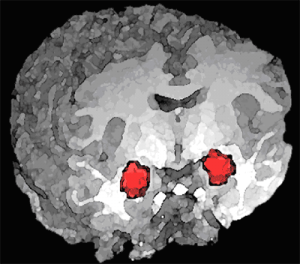 The amygdala has three layers of neurons. It is the center of much of the brain activity related to emotions.
The amygdala has three layers of neurons. It is the center of much of the brain activity related to emotions.
The top amygdala layer receives signals from the smell centers, and responds to faces, sounds and music—especially happy music. These responses are related to emotions connected with social contacts. During happy music there are strong connections from the amygdala to the dopamine driven nucleus accumbens (addiction center). This dopamine center is not as involved in fearful music.
A basic center of the amygdala, the laterobasal, is the main way sound information enters along with other senses. This center responds to both happy and fearful signals and is correlated with stimulation of goal directed behavior. Signals from higher cortical centers are mingled with this center for hearing and direct sensory input from the thalamus.
Nucleus Accumbens (NA)
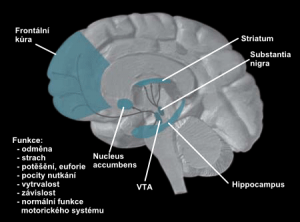 The NA is highly correlated with pleasure and is responsible for the chills and shivers—skin “goose bumps”—that occur with scintillating music or other emotions. It is the major center responding to the pleasure of food, drink, money, drugs and sex and is connected with activity that is motivated by rewards.
The NA is highly correlated with pleasure and is responsible for the chills and shivers—skin “goose bumps”—that occur with scintillating music or other emotions. It is the major center responding to the pleasure of food, drink, money, drugs and sex and is connected with activity that is motivated by rewards.
The NA is highly connected to many other brain regions, higher (cingulate cortex, anterior insula) and lower (thalamus – the center of incoming sensory data). All of these regions are involved in pleasure from music.
These centers are thought to be very old in evolution and related to survival. The power of music is intricately related to the earliest survival activity. This can been seen in music’s great importance for cohesion in all societies. When listening to music these pleasure centers are connected to the auditory cortex related to hearing. Interestingly, research shows that the more activity that occurs between the auditory cortex and the NA predicts whether a song will be purchased.
Hippocampus
 What is unusual about the hippocampus is that there is no evidence of response to the activity that produces rewards from food, sex and money. But, it is highly related to music and responds in ways that do not connect with the addictive reward system. Previously, the hippocampus has been most correlated to learning and memory, especially spatial orientation. With music, it appears to be related to all types of emotion—happy, sad, peaceful, chills, and fearful.
What is unusual about the hippocampus is that there is no evidence of response to the activity that produces rewards from food, sex and money. But, it is highly related to music and responds in ways that do not connect with the addictive reward system. Previously, the hippocampus has been most correlated to learning and memory, especially spatial orientation. With music, it appears to be related to all types of emotion—happy, sad, peaceful, chills, and fearful.
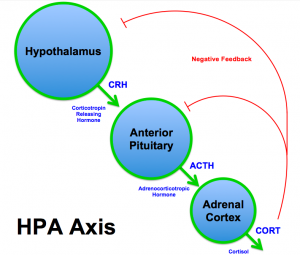
In recent years the view of the hippocampus has changed from just dealing with learning, memory and space because it is powerfully connected to the critical stress system of the hypothalamus, the pituitary and the adrenal—know as the HPA axis. The stress system is a key brain center – very connected to all types of emotional response including the critical stress reactions that impact the whole body and immune functions.
The hippocampus is damaged by severe stress, with reduction of new neuron production during depression, PTSD and abuse. During recovery from depression and stress, the production of new brain cells in the hippocampus increases.
Also, attachment and tender feelings are correlated to with the amount of new brain cells, with less new neurons when there are no tender feelings. These same people with less tender feelings have less response to music as well. Also, those who are subjected to persistent loud sounds that cause stress have reductions in the hippocampus activity and cells.
 In addition to cortisol receptors, the hippocampus has oxytocin receptors and is possibly connected to regulating the oxytocin release in the pituitary. Through this connection, the hippocampus affects parent child bonding and social attachment. Feelings of love and joy are, in part, related to the large connections beween the hippocampus, the HPA and other regions near the NA and the amygdala.
In addition to cortisol receptors, the hippocampus has oxytocin receptors and is possibly connected to regulating the oxytocin release in the pituitary. Through this connection, the hippocampus affects parent child bonding and social attachment. Feelings of love and joy are, in part, related to the large connections beween the hippocampus, the HPA and other regions near the NA and the amygdala.
In this regard, music has a strong effect on social activity and is used for social bonding including singing at religious services, the national anthem, marching and dancing. These effects of music are related to these strong connections of the hippocampus, amygdala and the HPA system. Such musical activities, also, are critical for survival of the community.
During musical social events, people are very focused, and have shared emotions and shared activity. Previous posts have shown that neuroplasticity effects are strongly  related to the size of the brain circuit. The most powerful effects often occur in the context of music with very large circuits including physical activity, emotional experiences, memory of related events and learning—all at the same time. Just tapping along with music at an event increases hippocampal activity and neuroplastic learning.
related to the size of the brain circuit. The most powerful effects often occur in the context of music with very large circuits including physical activity, emotional experiences, memory of related events and learning—all at the same time. Just tapping along with music at an event increases hippocampal activity and neuroplastic learning.
The effects of music in these situations includes a sense of participation that becomes an experience of a large “we” involving all of the participants. This is seen at rallies and spiritual events. The music automatically translates into a sense of community and a shared sense of movement. Social interaction is greatly increased in these situations including learning to perceive oneself as part of something bigger. In evolution, this function of music, which increases cooperation and socialization, might be the most important.
Music can decrease stress by decreasing cortisol in the HPA system. But, the opposite can occur with harsh stressful sounds.
In patients with frontal temporal dementia there is less ability to recognize music that is joyful, sad, or fearful. This correlates with loss of neurons in amygdala, OFC, cingulate and insula. Patients with specific amygdala and hippocampus damage have loss of recognition of emotion in music. A specific region in the parahippocampal cortex alters music that changes the experience of dissonant or unpleasant sounds to pleasant.
Music and Emotion
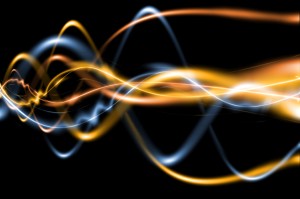 There have been several specific complex brain mechanisms that appear to be critical for music to have such unique effects in human emotions. Humans love listening to music as it engages the brain. Due to new technology, Multi-Room Audio Video Systems are also becoming popular as a way to enjoy music through both audio and vision. These are direct effects of music even without the additional effects of memories.
There have been several specific complex brain mechanisms that appear to be critical for music to have such unique effects in human emotions. Humans love listening to music as it engages the brain. Due to new technology, Multi-Room Audio Video Systems are also becoming popular as a way to enjoy music through both audio and vision. These are direct effects of music even without the additional effects of memories.
The first is the very complex effect of music causing increased interaction among people at many different levels. The second is the tension that is created by the structure of music and how this interacts with the brain. The third is the fact that affecting one region of muscles or nerves reverberates through the feedback loops causing increasing emotion. The following is a brief discussion of each.
How Does Music Increase Social Interaction
Human beings naturally engage in social events; they are inherently social and cooperative. Positive social experiences reward us with fun and happiness. Social rejection and isolation causes immune deficiencies (see post).
Music stimulates social interaction in many different ways. People join together in every  society to sing, drum and dance, which appears to fulfill this basic need for socialization. Experiencing music together, either listening or making music, increases general cooperation. This increased cooperation can decrease tension and conflicts and increase empathy because of shared experiences. Music leads to increased social group cohesion. It fulfills people’s need to belong.
society to sing, drum and dance, which appears to fulfill this basic need for socialization. Experiencing music together, either listening or making music, increases general cooperation. This increased cooperation can decrease tension and conflicts and increase empathy because of shared experiences. Music leads to increased social group cohesion. It fulfills people’s need to belong.
When listening to music, the brain attempts to understand the composer’s intentions, which stimulates social cognition. Also, in the interaction with parent and child, both language and music increase communication.
 A previous post on neuroplasticity showed that the strongest learning occurs when wide brain circuits are all used at the same time. This was demonstrated by increased learning when teachers point with their hands, and increased performance for high jumpers when they prepare with imaging that includes hand movements. (see post.)
A previous post on neuroplasticity showed that the strongest learning occurs when wide brain circuits are all used at the same time. This was demonstrated by increased learning when teachers point with their hands, and increased performance for high jumpers when they prepare with imaging that includes hand movements. (see post.)
When actions and movements are coordinated in a group through tapping, rhythmic clapping, dancing, marching this neuroplasticity occurs in the entire group at the same time. Coordinated movements are pleasurable as witnessed by social dances. It increases trust and cooperation. Even with babies, they prefer live music and drumming to a drum machine or recording.
At the finest level of performance in choirs, symphonies and bands, the very high level of cooperation increases future cooperation.
Tension – Musical Expectation
 Music creates a tension of a timed sequence of tones and chords. These structures have emotional effects. Some of the factors are the well-known dissonance and consonance, loudness, pace, and the qualities of the sounds as pleasant or not. These factors can increase enjoyment or tension.
Music creates a tension of a timed sequence of tones and chords. These structures have emotional effects. Some of the factors are the well-known dissonance and consonance, loudness, pace, and the qualities of the sounds as pleasant or not. These factors can increase enjoyment or tension.
Consonance and dissonance affects the auditory signal of the brainstem and affects activity in the amygdala. The higher cortical brain predicts what will happen and creates expectations that lead to a building emotional reaction and desire for it to continue in specific ways. The changes of the beat by increasing speed or slowing down affect these expectations. In melodic music, emphasizing the basic melody has a building effect. Leaving the basic pattern creates tension, which is resolved upon returning to the original pattern. The tension is rewarding if predictions occur and the more complex the route to the resolution the more satisfying. The context is important. For a simple dance there is little expectation. But, for spiritual music, the tension of sin and resolution of redemption become very important.
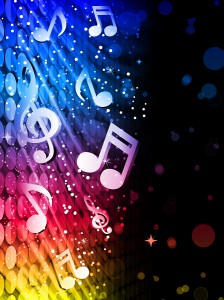 Surprise and not following predictions can have many effects even when the musical piece is listened to more than once. Unexpected events alter skin electrical conductance and in the amygdala with the degree related to how much it is not expected. Random chaotic changes don’t have this effect. In the unexpected events there is a bridge and then a resolution with an even stronger emotional reaction. The expectation of resolution becomes very strong and elicits a strong emotion.
Surprise and not following predictions can have many effects even when the musical piece is listened to more than once. Unexpected events alter skin electrical conductance and in the amygdala with the degree related to how much it is not expected. Random chaotic changes don’t have this effect. In the unexpected events there is a bridge and then a resolution with an even stronger emotional reaction. The expectation of resolution becomes very strong and elicits a strong emotion.
Because of this improvisation of all types has very powerful effects.
Certain chord patterns are so well known (a dominant seventh leading to a tonic chord) that they will bring about an anticipation of resolution that is very strong leading to dopamine in the reward centers.
Emotional contagion
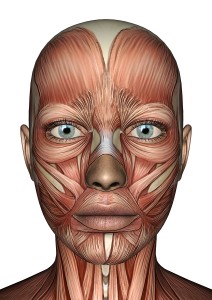 Physical reactions to specific types of music create a feedback loop in the autonomic nervous system that spreads strong emotions. An example is when happy music triggers the muscles in the jaw with increased electrical activity and an increase in breathing. Sad music stimulates the muscles surrounding the eyes.
Physical reactions to specific types of music create a feedback loop in the autonomic nervous system that spreads strong emotions. An example is when happy music triggers the muscles in the jaw with increased electrical activity and an increase in breathing. Sad music stimulates the muscles surrounding the eyes.
A feeling of happiness and sadness appear to be a feedback effect of these muscular activations.
Studies show that visual information takes precedence to music in the multi sensory brain (see post). Pictures, clips have dramatic  effects on the emotional reactions from music. Even facial and gestural expressions or movements, such as dance movements greatly increases emotions.
effects on the emotional reactions from music. Even facial and gestural expressions or movements, such as dance movements greatly increases emotions.
A provocative study showed that our judgments about a musical performance might have more to do with sight that the sound. In this study of both trained and untrained musicians observing music competition, judgment about the quality of a music performance depended more on how a musician moves and looks than what they sound like.
In fearful reactions to music the auditory cortex is highly connected with the visual cortex, the insula and cingulate cortex. These visual and auditory circuits are part of a generalized reaction to fearful situations. When a fearful sound is heard, the visual center immediately scans for fearful images as well.
Music Stimulates Emotions Through Specific Brain Circuits
Musical effects on the brain are found to be more fundamental the more that is learned about the brain. The unique effects of music on the brain appear to work through core brain circuits that connect people into cooperative social interactions including bonding of parent and child. These effects of music have been important in evolution.
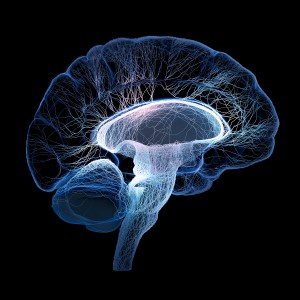 Very ancient reactions to danger utilize fundamental multi sensory aspects of the brain, which are stimulated by music; this includes the connections of the vestibular, visual and auditory systems. Different types of music stimulate different emotions and increase signaling in the endocrine systems including the critical stress circuits of the hypothalamus-pituitary-adrenal axis. Music also influences oxytocin, the hormone related to bonding. Feedback loops throughout the brain including the emotion centers, the addictive centers, memory, and the higher cortical centers, are all stimulated by music causing increased socialization. The socializing affects of music are demonstrated in every society with singing, drumming, dancing, tapping and marching being critical activities. These effects of song are also expressed in many animals, especially birds.
Very ancient reactions to danger utilize fundamental multi sensory aspects of the brain, which are stimulated by music; this includes the connections of the vestibular, visual and auditory systems. Different types of music stimulate different emotions and increase signaling in the endocrine systems including the critical stress circuits of the hypothalamus-pituitary-adrenal axis. Music also influences oxytocin, the hormone related to bonding. Feedback loops throughout the brain including the emotion centers, the addictive centers, memory, and the higher cortical centers, are all stimulated by music causing increased socialization. The socializing affects of music are demonstrated in every society with singing, drumming, dancing, tapping and marching being critical activities. These effects of song are also expressed in many animals, especially birds.
The more that is learned about music, the more it is found to have unique effects in evolution, human life and the circuits of the brain. Music plays many very critical roles in human society, including social connectedness, learning and spirituality.